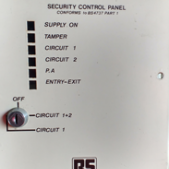-
Posts
11,712 -
Joined
-
Last visited
-
Days Won
185
PeterJames last won the day on November 23
PeterJames had the most liked content!
Profile Information
-
Gender
Male
-
Interests
I like nerdy stuff but only when it bloody works
Location
-
Location
Sussex
Recent Profile Visitors
PeterJames's Achievements
-
No hostility just pointing out this is not facebook, we dont give out engineer codes here for the same reason we dont give out engineering manuals.
-
This isnt facebook!
-

Help selecting new intruder alarm
PeterJames replied to Hollanda's topic in General Security & Fire Queries
On how many come up, it depends on the direction of the joists if theyre going the right way just a few need to come up. Old boards can become damaged when lifted if you are wanting to sand boards that may need to be lifted and not use floor coverings, you will need to consider carefully if wireless might be a better option. Engineers will do their best not to damage the boards, but its never that simple.- 55 replies
-
- wireless rf
- wireless alarm
-
(and 3 more)
Tagged with:
-
Coming back to this, does anyone know if the heat battery Solo is not as good as the mains Solo? I have 2 mains Solo's and 4 battery ones, one of my moany engineers keeps saying that we need mains more heat testers as the battery ones are not good enough to test high heats
-
-
I was on holiday in sitting in a cafe in Cheddar Gorge a few years ago watching a chap installing an alarm system in the building opposite. He used a measuring tape to work out where the bell would come out, he drilled the hole and still came out in wrong place right in the centre of a molding. Ive always drilled by eye using common sense and judgement and normally the hole is where I predict it will be, I did a video doorbell for a neighbour once, I was a bit tipsy at the time (Sunday afternoon half a bottle of red), every hole drilled was perfect. He still talks about how I installed his video doorbell drunk
-

Help selecting new intruder alarm
PeterJames replied to Hollanda's topic in General Security & Fire Queries
If you have wifi version then its a simple case of switching on the sim, if you dont have either then its a case of plugging in a module. Im probably the only NSI gold company here that covers South London Al-Yeti covers South London but he is not accredited- 55 replies
-
- 1
-

-
- wireless rf
- wireless alarm
-
(and 3 more)
Tagged with:
-

Help selecting new intruder alarm
PeterJames replied to Hollanda's topic in General Security & Fire Queries
You look after one!- 55 replies
-
- 1
-

-
- wireless rf
- wireless alarm
-
(and 3 more)
Tagged with:
-

Help selecting new intruder alarm
PeterJames replied to Hollanda's topic in General Security & Fire Queries
Im not a fan of either but I hear less people complaining about the Texecom app going down on the FB forums- 55 replies
-
- 1
-

-
- wireless rf
- wireless alarm
-
(and 3 more)
Tagged with:
-

Help selecting new intruder alarm
PeterJames replied to Hollanda's topic in General Security & Fire Queries
You can but its not recommended Price for what your getting sounds a little expensive, but there are a few unknowns like parking and any other misc charges.- 55 replies
-
- 1
-

-
- wireless rf
- wireless alarm
-
(and 3 more)
Tagged with:
-

Help selecting new intruder alarm
PeterJames replied to Hollanda's topic in General Security & Fire Queries
Its hard to give a price without seeing the property and whats involved, did they give you a proper specification detailing what and where items will be installed. Its not unusual for companies not to do the fused spur as officially you have to certify them. (From your original post I forgot to add it to my first reply) The panel does let you know when the batteries are low. Al-yeti and I both cover South London, Al-yeti may be your better bet though as we are quite busy. Neither of us sell Texecom though, only HKC.- 55 replies
-
- wireless rf
- wireless alarm
-
(and 3 more)
Tagged with:
-

Help selecting new intruder alarm
PeterJames replied to Hollanda's topic in General Security & Fire Queries
Banham will be rebranded Pyronix. If they are all similar price to Banham then they are all dearer than average. Banham tend to be on the expensive side. Thats not to say thats a bad thing, as you should not be looking for the cheapest Out of Texecom and Pyronix Id probably choose Texecom. Wireless kit is far more reliable than it was 10 years ago, I would always recommend hard wired over wireless but I am old school. Batteries can last up to 3 years we tend to replace them yearly though because its cheaper than calling us out between services, and that has happened a few times for us, we are happy to leave them for two years but insist the customer signs to say they understand the consequences. Servicing is probably the most important bit to alarms, these things go wrong and when they do they are a nuisance. Having a service contract isnt just about having a service visit either, think of it as being a bit like having AA or RAC for your alarm. A service contract means someone is available 24/7 365 days which I am sure you can imagine is quite an expensive service to provide.- 55 replies
-
- wireless rf
- wireless alarm
-
(and 3 more)
Tagged with:
-

Best Practices for Security System Installation
PeterJames replied to fivider's topic in Members Lounge (Public)
Hi this is a UK based forum and products in this country are made specifically to the UK rules and regulations for the UK. The rules in other countries are quite different to UK therefore anything we suggest thats not DIY will either be unavailable where you are or not compatible with Canada equipment. All of us here wouldnt recommend anything specifically sold as DIY as we are all professionals here. Take a look at the DSC panels this is Canadian pro brand that used to be sold in the UK. Please dont post links in your posts thanks -
Ask your boss if you can take stuff home to wire up and play with, if he is a good boss he should be impressed.(If he isnt he isnt a good boss) I learned loads at home on with old panels that I had removed to update, as well as new panels that I was installing. There is nothing like it for gaining confidence in how to program panels and how to wire them etc. Make sure you have the engineers manual for any old panels that you take home, as the programming is not the same as the ones you currently install. Well done for finding here and asking, many young lads/lass's wont have the initiative to do that, you are obviously keen, stick around we will help where we can.
-

Old Chubb alarm boxes.
PeterJames replied to AlarmALot Systems's topic in Vintage For Sale, Items Wanted, auction links
Ive often thought about that when fitting boxes to old buildings. The ticket office for West Pier got me thinking, the building was 150 years old so it got me wondering how long my bell box would be there for. Sadly the foockers knocked the building down so they could put up the very unsuccessful i360.







